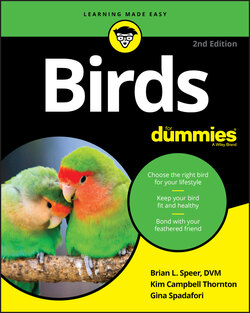Читать книгу Birds For Dummies - Gina Spadafori - Страница 89
Considering size: Bigger is better
ОглавлениеThe first rule of caging: Buy the biggest cage you can afford. Forget the generic categorization you’ll find in pet stores of “finch cage,” “budgie cage,” “small parrot cage,” and so on. Those descriptions represent the minimum size to consider — a better bet is at least one size bigger. No cage is too large, but plenty are too small for a bird’s needs.
No matter how much attention you’re able to devote to your bird, she’ll still spend a lot of time cooped up — almost all her life, in the case of canaries and other finches. Give your bird a break, right from the start, and buy a cage that will allow her as much freedom of movement as possible.
Cages may lack in an important dimension: width. Those tall and narrow circular cages may look nice, but they force birds to fly more like a helicopter than in the style that comes naturally for them. Remember to consider the way the birds move. Finches and canaries usually prefer to fly horizontally, not vertically. Parrot species like to fly horizontally, as well as climb up and down in their cages.
The only problem with buying a cage larger than commonly recommended is that the bar spacing may be the wrong size for your bird. Before you buy any cage, make sure your bird can’t put his head through the bars. Some pets accidentally catch themselves this way, resulting in injuries or even death. Fortunately, many manufacturers of high-quality cages offer different bar-spacing options on their models, so you can get a large cage of the dimensions that are best for your individual bird’s needs. The basic bar spacing for cockatiels is about ¾ inch; finches require smaller bar spacing, and Amazons and macaws need larger.
